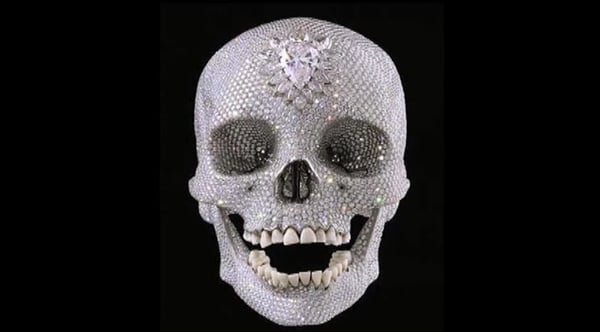Art World
Turns Out the Diamond Skull That Damien Hirst and White Cube Said They Sold for $100 Million in 2007 Still Belongs to Them
The work appears to have been inside a storage facility in London for 15 years.

The work appears to have been inside a storage facility in London for 15 years.

by
Artnet News

Damien Hirst, who in 2007 claimed to have sold a diamond-studded skull for £50 million ($100 million) to a group of anonymous investors, has officially admitted that the deal never actually happened.
In a profile published in the New York Times on the occasion of his first New York show in four years, Hirst said the work, titled For the Love of God and allegedly made from more than 8,600 diamonds, was sitting in a storage facility in Hatton Garden, London’s jewelry district.
According to Hirst, he still owns the bauble in partnership with his gallery, White Cube, and a group of unnamed investors.
The splashy sale, which White Cube announced in August 2007, was covered by reputable news sources at the time as a done deal.
But considering the hype behind the skull, and the fact that the gallery offered no concrete evidence about the sale, there was always doubt as to whether it had actually traded hands.
Inconsistencies in Hirst’s story didn’t help. When the work was revealed in 2006, he claimed to have financed the full £8 million ($16 million) to create the skull himself. But when it finally went on view at White Cube, he said the real figure was £15 million ($30 million).
When White Cube announced the sale, Cristina Ruiz, then editor of the Art Newspaper, wondered why the news was being revealed just after she had reported that Hirst and the gallery had tried to offload the work at a severely discounted price of £38 million ($76 million).
“On the day we said they were negotiating a discount for buyers, suddenly, miraculously, it has been sold for £50 million, cash,” she told London’s Evening Standard at the time. “How likely is that? Cash is convenient because there is no paper trail.”
Others, including professional jewelers, wondered how the work could possibly have cost £15 million to make.
“I would estimate the true worth of the skull as somewhere between £7 million and £10 million,” Harry Levy, then the vice-chairman of the London Diamond Bourse & Club, told the Evening Standard.
Along with the sale announcement, White Cube said that Hirst would keep a “share” of the work “in order that he can oversee a global tour of the work that is currently being planned.”
That share, it seems, is just a bit bigger than implied.
Back in 2007, Hirst’s market was exploding. The same year he said he sold For the Love of God, his work made a total of $86.3 million at auction, according to the Artnet Price Database. The following year, he notoriously sold his work directly through Sotheby’s for a whopping $201 million. But his auction sales never approached those heights again. (Last year, his work generated $38 million, a 13-year high.)
More than anything, Hirst’s admission pulls back the curtain on an industry in which hype often appears to be plain fact.
In the recent Hirst New York Times profile, the newspaper took at face value the artist’s claim that he sold around 80 new works for between $750,000 and $3.5 million each.
“We could have sold many, many more,” Larry Gagosian told the Times. “People were literally begging to buy these paintings.”
Neither White Cube, nor Science Ltd., Hirst’s production company, responded to requests for comment.